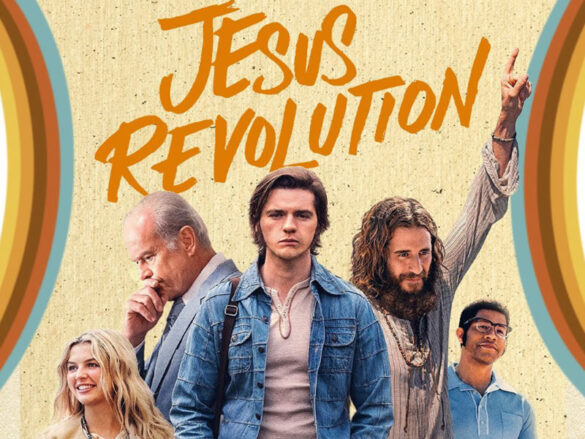By William H. Benson
The Parallel Lives
Of The NOBLE AMERICAN RELIGIOUS THINKERS AND BELIEVERS:
Roger Williams VS. Cotton Mathers
NEW ARTICLES

Explo ’72
Explo ’72
This last week I watched the new Lionsgate film, “Jesus Revolution.” The film did better than expected, grossing $50 million in the first months after its release in February.
The screenplay is based upon a memoir that Greg Laurie, and co-writer Ellen Vaughn, published in 2018, “Jesus Revolution: How God Transformed an Unlikely Generation and How He Can Do It Again Today.”
I knew nothing of Greg Laurie when I watched the movie, but since then, I have learned that he is a long-time pastor, fifty years now, at a megachurch called Harvest Christian Fellowship in both Riverside and Irvine, California.
The screenplay includes four people: Greg, his girlfriend Cathe, a charismatic bearded hippy named Lonnie Frisbee, and a former Foursquare pastor named Chuck Smith.
In the early 1970s, Greg was in high school and lived with his alcoholic mother in a trailer house parked at Newport Beach. Throughout the film, he struggles to find his way, to re-create a more stable home and family, and find a career.
He heads down the wrong path for a short time, but other people, including Cathe, Lonnie, and Chuck, redirect him.
Lonnie and Chuck agree to conduct a mass baptism on a Saturday at Pirate’s Cove, at Newport Beach. Over the next several weeks, the two men baptize hundreds and then thousands of young people in the Pacific Ocean, including Cathe and Greg.
A break between Lonnie and Chuck over the appropriate style of worship at Calvary Chapel forces Greg to choose between them. Lonnie heads to Florida.
It is the film’s final scene that resonated with me. It is that of Explo ‘72, in Dallas, Texas, a gathering sponsored by Bill Bright’s organization “Campus Crusade for Christ.”
High school and college-aged students from across America showed up from June 12 to June 17, 1972, for a week of training in mission work, fifty-one years ago this month.
Three weeks after I graduated from Sterling High School, in May, I made the trek to Dallas. My ride dropped me off at Dallas Baptist College, and I checked into a dorm.
Days we attended seminars on campus, where instructors tried to teach us how to minister door-to-door, by passing out tracts. Afternoons we knocked on doors.
Towards evening, city buses would haul us to the Cotton Bowl, where we listened to a series of vocalists, bands, and sermons, including Johnny Cash, Kris Kristofferson, and Andre Crouch. Billy Graham spoke mid-week.
The final scene of “Jesus Revolution” shows a clip of Billy speaking to a crowd of almost 80,000 students, in the Cotton Bowl. He wore a powder blue suit, white shirt, and tie.
In that clip, he says, “This is a demonstration of the love of God by tens of thousands of young people, saying to the world that God loves you. It’s the Jesus revolution that is going on in this country.” Pictures of the actual Greg, Cathe, Lonnie, and Chuck follow.
At Explo ‘72, I did not see many, if any, hippies or flower children, like those seen at Haight-Ashbury in San Francisco. Those who attended were typical high school and college-aged students, who wore normal clothes, shoes, and sported no beards.
I think the film makes a mistake by conflating as the same two distinct organizations, Chuck and Lonnie’s “Jesus Movement” in southern California, and Bill Bright’s “Campus Crusade for Christ,” a college-oriented ministry spread across the fifty states.
In all, I thought the movie was worth watching. Kathy Schiffer, a journalist, said, “If you’re old enough to remember the 1960s and ’70s, you’ll find Lionsgate’s upbeat new film ‘Jesus Revolution’ to be a walk down memory lane.” Indeed, it was, especially the music.
I might mention that Kelsey Grammer, of “Cheers” and “Frasier,” plays Chuck Smith, and that Jonathan Roumie, of “The Chosen” television series, plays Lonnie Frisbee.
JUMPING THE SHARK
JUMPING THE SHARKJUMPING THE SHARK by William H. Benson November 24, 2011 The expression “jumping the shark” refers to that Happy Days' episode that aired on September 20, 1977 when Fonzie, on water-skis and dressed in trunks and his trademark leather jacket,...
THE HUNDRED MOST
THE HUNDRED MOSTTHE HUNDRED MOST by William H. Benson November 10, 2011 Last Monday the British Museum published in the United States its book The History of the World in 100 Objects. Over a four-year stretch a hundred curators at the London museum selected a...
CHARACTER
CHARACTERCHARACTER by William H. Benson October 27, 2011 In its September 18th edition, the New York Times Magazine ran an article on an interesting subject, developing students' character. Dominic Randolph, the headmaster at New York City's Riverdale Country...
CHRISTOPHER COLUMBUS
CHRISTOPHER COLUMBUSCHRISTOPHER COLUMBUS by William H. Benson October 13, 2011 Christopher Columbus completed four voyages to the Western Hemisphere. It was a tribute to his single-minded focus, his daring, his exemplary seamanship skills, his persuasive ability,...
ERROL MORRIS’S “BELIEVING IS SEEING”
ERROL MORRIS'S “BELIEVING IS SEEING”ERROL MORRIS'S “BELIEVING IS SEEING” by William H. Benson September 29, 2011 In the September 4th edition of the New York Times Book Review, I happened to read an interesting review of a new book, Errol Morris' Believing is...
BILL BRYSON’S “A WALK IN THE WOODS”
BILL BRYSON'S “A WALK IN THE WOODS”BILL BRYSON'S “A WALK IN THE WOODS” by William H. Benson September 15, 2011 Bill Bryson, the writer, moved back to the United States in 1995, with his British-born wife and their four children, and settled in Hanover, New...
Older Posts
SHAY’S REBELLION
SHAY'S REBELLIONSHAY'S REBELLION by William H. Benson September 1, 2011 Daniel Shays was bankrupt and angry. A farmer in rural Massachusetts and a former captain in the army, he gathered about him a number of debt-ridden farmers who had fought in the last war,...
AMERICAN GRAFITTI
AMERICAN GRAFITTIAMERICAN GRAFITTI by William H. Benson August 18, 2011 George Lucas had by 1972 directed only one full-length feature film THX 1138, a science-fiction film that failed, but he had ideas for two other films. The first was autobiographical, of his...
TRIVIAL KNOWLEDGE
TRIVIAL KNOWLEDGETRIVIAL KNOWLEDGE by William H. Benson August 4, 2011 “History is more or less bunk,” said Henry Ford. “We don't want tradition. We want to live in the present, and the only history that is worthwhile is the history we made today.” An interesting...
Domestication
DOMESTICATIONDOMESTICATION by William H. Benson July 21, 2011 It is summer. We know it is so because we see the things we associate with summer: a slice of watermelon, strawberries, corn on the cob, a grilled hamburger, perhaps a fried chicken leg or pork ribs...
STEVE MARTIN
STEVE MARTINSTEVE MARTIN by William H. Benson July 7, 2011 The funniest comic performance I can remember seeing when a child was what happened one night on The Dean Martin Show, perhaps in the year 1964. Dom Delouise, a young comedian then, came out onto the...
THE BERLIN WALL
THE BERLIN WALLTHE BERLIN WALL by William H. Benson June 23, 2011 On March 5, 1946, less than a year after the conclusion of World War II, Winston Churchill spoke at Westminster College in Fulton, Missouri and said, “From Stettin in the Baltic to Trieste in the...

One of University of Northern Colorado’s 2020 Honored Alumni
William H. Benson
Local has provided scholarships for history students for 15 years
A Sterling resident is among five alumni selected to be recognized this year by the University of Northern Colorado. Bill Benson is one of college’s 2020 Honored Alumni.
Each year UNC honors alumni in recognition for their outstanding contributions to the college, their profession and their community. This year’s honorees were to be recognized at an awards ceremony on March 27, but due to the COVID-19 outbreak that event has been cancelled. Instead UNC will recognize the honorees in the fall during homecoming Oct. 10 and 11……
Newspaper Columns
The Duodecimal System
For centuries, the ancient Romans calculated sums with their clunky numerals: I, V, X, L, C, D, and M; or one, five, ten, 50, 100, 500, and 1,000. They knew nothing better.
The Thirteenth Amendment
On Jan. 1, 1863, President Abraham Lincoln signed the Emancipation Proclamation, and by it, he declared that “all persons held as slaves” within the rebellious states “are and henceforward shall be free.” Lincoln’s Proclamation freed some 3.1 million slaves within the Confederacy.
The Fourteenth Amendment
After Congress and enough states ratified the thirteenth amendment that terminated slavery, Congress passed the Civil Rights Act of 1866. This law declared that “all people born in the United States are entitled to be citizens, without regard to race, color, or previous condition of slavery or involuntary servitude.” The Act equated birth to citizenship.
The New-York Packet and the Constitution
Jill Lepore, the Harvard historian, published her newest book a month ago, These Truths: A History of the United States. In a short introduction, she describes in detail the Oct. 30, 1787 edition of a semi-weekly newspaper, The New-York Packet.
Mr. Benson’s writings on the U.S. Constitution are a great addition to the South Platte Sentinel. Its inspiring to see the history of the highest laws of this country passed on to others.
– Richard Hogan
Mr. Benson, I cannot thank you enough for this scholarship. As a first-generation college student, the prospect of finding a way to afford college is a very daunting one. Thanks to your generous donation, my dream of attending UNC and continuing my success here is far more achievable
– Cedric Sage Nixon
Donec bibendum tortor non vestibulum dapibus. Cras id tempor risus. Curabitur eu dui pellentesque, pharetra purus viverra.
– Extra Times
FUTURE BOOKS
- Thomas Paine vs. George Whitefield
- Ralph Waldo Emerson vs. Joseph Smith
- William James vs. Mary Baker Eddy
- Mark Twain vs. Billy Graham
- Henry Louis Mencken vs. Jim Bakker






